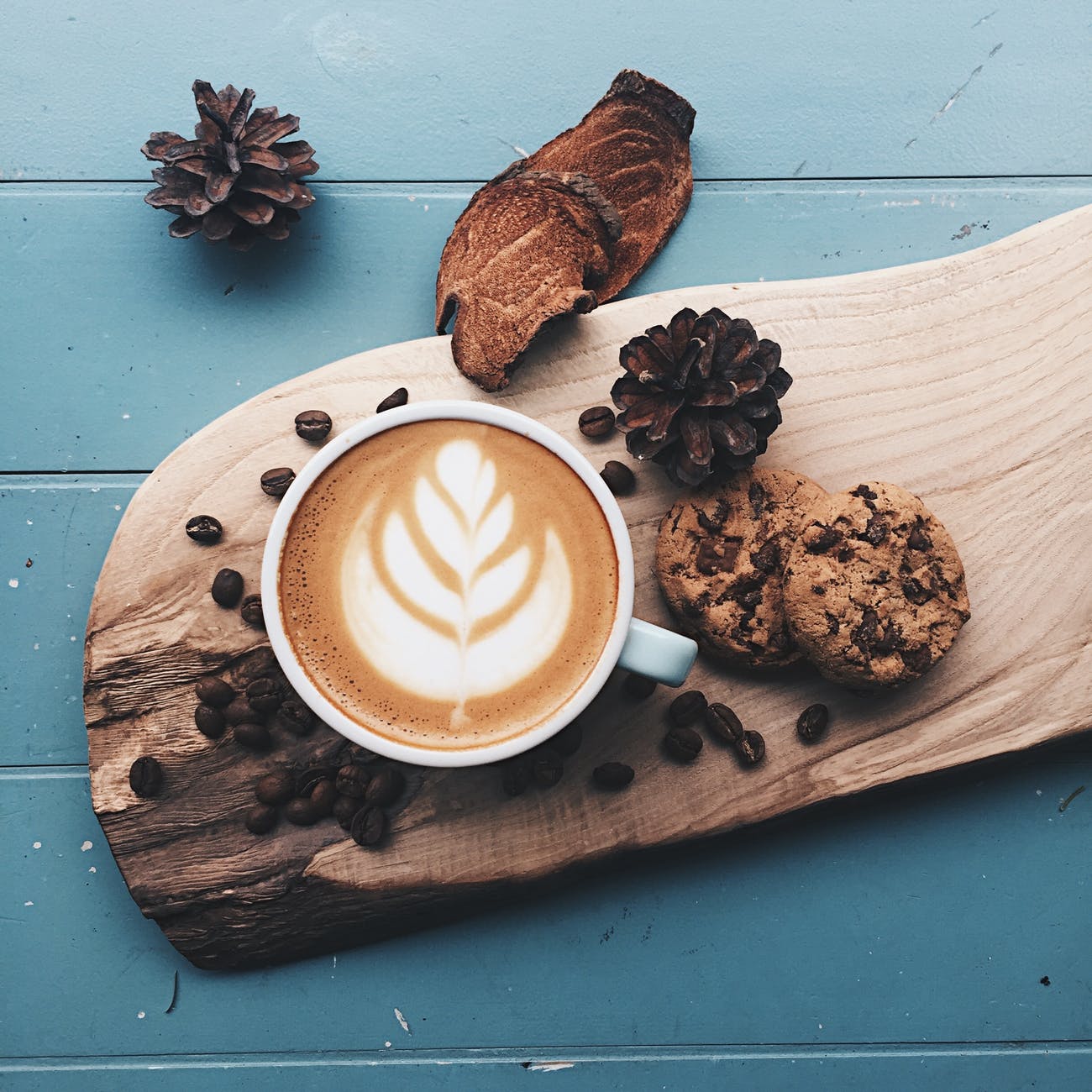Make your morning drinks at home for a better morning ritual

A few minutes every morning is all you need.
Stay up to date on the world's Headlines and Human Stories. It's fun, it's factual, it's fluff-free.
With autumn kicking up, the weather getting colder and the mornings darkening, it’s difficult to ignore the urge to grab a hot coffee (or tea or hot chocolate) on the way to work. I mean, who wants to wake up 10 minutes early to get their favorite beverage just right?
We get it; it’s tough to resist the seasonal lattes at our favorite independent coffee shops (or even the ones at Starbucks). Plus, not everyone has time, or even knows how to make whipped coffee or a mocha-frappe-latte-whatchamacallit.
But, our morning drinks can really add up when we order out. A single beverage can sometimes cost north of US$7. And those Starbucks drinks are notoriously high in sugar, which is great for the occasional treat – but probably not ideal for everyday consumption.
There’s nothing wrong with keeping these comfort drinks a part of your morning repertoire. In fact, taking some extra time for yourself in the morning to prepare for the day with an energizing cup of coffee can even be good for your overall well-being.
TMS discussed the benefits of morning rituals with nutritional psychiatrist and chef Uma Naidoo – a board-certified psychiatrist and graduate of the Cambridge School of Culinary Arts, as well as author of the bestselling book, “This Is Your Brain on Food.” Her research provides insight into the connection between food/nutrition and mental health. On the health benefits of a morning ritual as a reprieve from the rest of the day, Dr. Naidoo explained:
“I love having a morning routine and encourage everyone to consider developing one. Establishing certain rituals that we start the day with is a proven way to begin each day emotionally well and with feelings of purpose. My own daily meditations and mood-boosting golden milk help me to start each day ready for success. My special recipe is something I made with my grandma, to whom my book is dedicated, and has a special meaning for that reason, but also contains turmeric, one of my go-to spices.
“Some of you may enjoy a cup of coffee while catching up on the news, listening to an educational podcast while sipping on an energizing cup of green tea or matcha, taking your pet for a walk to your local coffee shop [or] simply spending uninterrupted time with a loved one before the day begins,” Naidoo continues. “Green tea contains the bioactive EGCG and L-theanine, both brain-boosting nutrients. These routines provide focus as we start each day and have been suggested as especially effective for those with ADHD to have a productive day.”
That said, we’ve got some suggestions for preparing your morning drinks at home, rather than buying a cup on the way to work. So, read on and become your own barista.
Where to start with equipment
One of the major pros of ordering coffee at a shop is that most of us can’t afford professional-level equipment to make our favorite morning drinks. Some of these machines cost thousands of dollars, which just can’t be justified if we’re trying to save money.
However, just because we can’t all manage to rack down top-of-the-line equipment doesn’t mean anyone should have to rely on instant coffee. Respect yourself. Actually, there are many gadgets that you can use with minimal effort that even a college student could afford.
For both coffee and tea lovers, a French press may be the best option for you. A French press is a receptacle that pushes hot water through coffee grounds or tea leaves, depending on what you like to drink. Costing between US$10-30 on average, a French press is a worthwhile, affordable investment.
You can make an entire pot of coffee using one if you’re sharing. Use a medium-grind coffee if you’re thinking about making this purchase. If you want to make tea with one, then use loose tea leaves and make sure to pay attention to the temperature of the water you’re using.
For individual cups of coffee and tea, you can use smaller, less complex appliances. For coffee, the AeroPress is an easy option. It works much like a French press but brews just a single cup. For tea, a quality tea strainer that you pour hot water over can’t be beaten.
For the espresso drinkers out there (that means you, latte fanatics), you can, of course, buy an espresso machine. However, these can get a little pricey. Instead, consider getting a Moka-pot, a stovetop Italian coffee maker that’s perfect for smaller amounts of coffee – and espresso especially (there are mini versions). They usually don’t go over US$30, and the mini version for espresso is even less. Who doesn’t love Italian espresso?
Then, if you want to latte it up, an electric milk frother is always fun to have and usually costs around US$10. Plus, if you love matcha green tea (and matcha lattes), a milk frother is great for mixing matcha into water without it clumping up.
But buying coffee at a shop makes it so much better…
We wouldn’t all be caffeine addicts if coffee didn’t taste so good. Especially when our favorite barista makes it. Of course, going out a few times a week to get a nice warm drink is nothing to feel guilty about. Treat yo’self!
Coffee shops and cafes have access to many specialty ingredients and recipes that most of us are unfamiliar with. Luckily, we have access to the internet, which has all of the resources any of us could possibly need.
While many of us are satisfied with a regular cup of coffee, maybe with sugar or milk, not everyone enjoys their morning drinks that way. And there’s no shame in that, despite what coffee purists may lead you to believe.
For more complicated drinks, you can find recipes all over the internet that will satisfy your taste buds and allow you more control when it comes to certain ingredients and allergens. And, hey, you can get those seasonal drinks all year round when you make them in your kitchen. White chocolate mocha in July – why not?
Dr. Naidoo explains that making your morning drinks at home can also improve your physical health and wellness. “Making coffee shop beverages at home is an important way to be in control of what ingredients we are and are not consuming. As a trained chef, I care deeply about the source of any ingredient as well as what I put in any food or beverage I am preparing.
“This gives us the option to use healthy, unsweetened plant-based milks rather than sugary creamers that come standard in many coffee shop drinks. Similarly, we have the option to avoid added sugars or sweeteners that we may not even be able to taste that can still disrupt the microbiome and eventually our mental health.
“When we make our own beverages, we are able to get back to basics. Beverages like coffee and tea tend to be healthiest in their most natural state, which is more so how we have it at home without coffee shop additives. Similarly, preparing our morning beverages at home allows us the potential to also enjoy mood-boosting alternative items that are not available at many coffee shops.
“For example, I love making my recipe for a golden milk turmeric latte with coconut milk, turmeric and a pinch of black pepper to start my day with focus and anti-inflammatory ingredients. However, coffee shops that do offer turmeric beverages tend to load them with sugars and sweetened creamers. The same goes for popular matcha lattes. If you consume dairy you can make any of these beverages using an organic grass milk dairy compared to cheaper less healthy dairy that most stores would use.”
For instance, the famous (or is it infamous?) Starbucks Pumpkin Spice Latte recipe is available right on their website. In fact, recipes for pretty much all of their drinks are available for free online. So feel free to mix it up, replacing milk with nondairy alternatives or using a different coffee roast, or changing the sweetness levels to make your morning drinks absolutely perfect.
Not a fan of Starbucks? You don’t have to emulate their recipes, but instead, try out some other recipes that seem good to you and what you’re craving. There are so many coffee recipes and ideas online that it’s hard to decide what to try next! Your favorite coffee shop may even sell the coffee beans they use, or maybe they even have a cookbook for your reference. These resources are great if you want to continue to support an independent cafe without necessarily spending US$5 there every day.
“When making beverages at home, we have the ability to include brain foods that can support a positive mood and feelings of well being for fun and improved taste,” points out Dr. Naidoo. “For example, rather than a store-bought mocha full of sugar and unhealthy fats, one could mix antioxidant-rich cacao with coffee and unsweetened coconut milk for added healthy fats. Vanilla or mint syrups are a popular additive to flavor beverages, especially in the winter but are similarly full of processed sugars.
“Did you know that we can brew both vanilla, mint tea or even cinnamon tea or similar flavors without the sugar but with the added benefits of antioxidants? Fresh mint also contains an important antioxidant that beats brain fog. It is important to remember that many of the flavors used in store-bought beverages are derived from natural foods, which we can make at home and still reap their benefits.”
So, what are you waiting for? Set your alarm just a tad earlier to make your own morning drinks and reap additional benefits all day long. BYOB – Be Your Own Barista!
Have a tip or story? Get in touch with our reporters at tips@themilsource.com




Comments ()